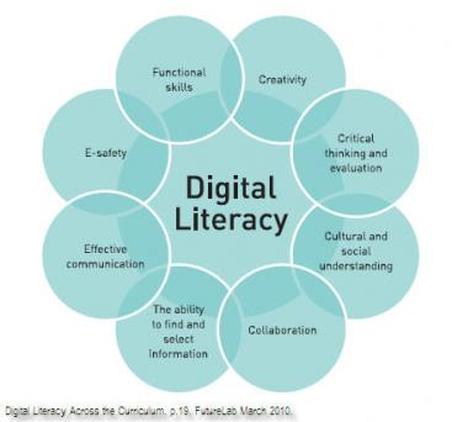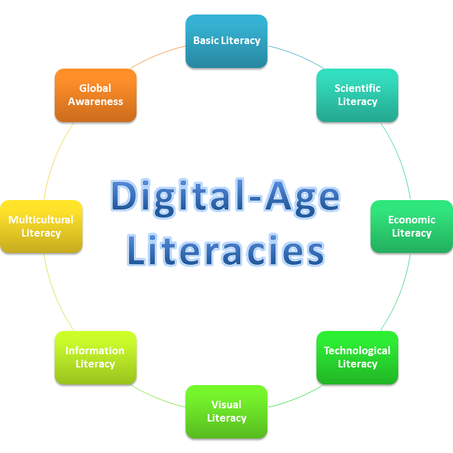
As you can see, digital literacy encompasses many concepts and skills. What teacher has time to introduce all these ideas and effectively teach students the ins and outs so that his/her students are truly digitally literate? But if it's a team effort, something the whole school takes on, then it becomes within the realm of possibility. If it starts early in a student's life, the skills can be reinforced and refined throughout their schooling.
"It is important to understand that information literacy is best addressed at multiple levels in the education process. Think of reading-comprehension skills that begin pre-K and continue through college lit courses. The skills are built upon with appropriate instruction at each stage of learning. This is also the ideal approach to information literacy skills, introducing the skills in the early years, building on them as the student advances through elementary school, and introducing new concepts of knowledge-seeking and analysis through middle school, high school, and post-secondary education." Averill, Debe, and Nancy Lewis. "Students and Information Literacy: High School and Postsecondary Perspectives." Maine Policy Review 22.1 (2013) : 114-117, http://digitalcommons.library.umaine.edu/mpr/vol22/iss1/28
It's not difficult to incorporate technology into the lesson plan. All the research shows that teachers must meet students where they are at; our students are digital natives so it makes sense to use technology to reach them. Blogs, web pages, email and video chats, Facebook pages, writing, illustrating and publishing stories, weekly discussion questions, etc., there are a million ways to use tech in the classroom. Digital literacy is not confined to the language arts classroom, either.

http://purposefultechnology.weebly.com/how-can-we-embed-digital-literacy-in-the-classroom.html
These literacies match up with the traditional math, science, social science, and humanities classes. Within all these curriculums there is a place to teach digital literacy, as we want our students to be critical thinkers who can evaluate the validity and reasoning of the information they seek. In every grade level of the Common Core State Standards students are expected to use a variety of digital tools to create and publish their writing. NETS has 6 categories of technology standards that include all the elements of digital literacy. These skills are already part of our objectives and learning targets. But by going digital this is a vast change for any teacher who is not a digital native. Watch this video to get motivated to work with your students!
https://www.youtube.com/watch?v=Mirxkzkxuf4
"The purpose of media literacy education is to help individuals...develop the habits of inquiry and skills of expression they need to be critical thinkers, effective communicators and active citizens in today's world."
( Media Literacy as Literacy for the Information Age, Renee Hobbs, Ed.D. Temple University,
This should be the mission statement of my high school. Times have changed and the purpose of education needs to change as well. How can we do this? Bringing in contemporary media and popular culture to our classrooms will deepen engagement and increase motivation, the research shows. Students learning multimedia production can apply some of the same rhetorical devices and skills as in traditional writing classes. Media and/or digital literacy can improve reading comprehension. There are questions, still, about digital literacy. One of the most important is: What instructional approaches using online sources and popular culture are most effective in improving reading comprehension and writing skills?
Research still needs to be done in this field...
Very interesting idea to include media literacy/information literacy in a school's mission statement! That would be incredibly powerful. Imagine if your high school partnered with your elementary school and each grade level focused on a different component of information literacy (thus scaffolding each year)- by the time they got to you in high school they would have an incredible mindset established to address media literacy. It's not as hard as we might think it is. After all, as you mentioned it is embedded into Common Core so we should be addressing it already.
ReplyDeleteI love this idea!
DeleteI explored media literacy as well and mentioned in my blog post about the importance of having a school-wide understanding of the topic as you did. It is a difficult skill to learn, so students need as much exposure to the skill in a variety of contexts. I like how you describe how media fits in to every subject and every curriculum, so it would be easy for teachers of various levels and subjects to work together on addressing this skill within their classrooms. Have you incorporated digital literacy into your instruction at all in the past? What suggestions do you have for teachers that may not have a wide background in general technology skills to teach students about digital literacy?
ReplyDeleteI couldn’t agree more that literacy is a school-wide, multi-disciplinary project. It seems like there is finally a dovetailing of various elements, frameworks, etc. of our profession like CCSS, literacy programs of all sorts, project-based learning, and the like. This convergence could help make the case to colleagues who are reluctant or anxious about incorporating digital learning into their instruction. It could also be a convincing lever for administrators in convincing them to invest in deep, long-term PD for digital instruction.
ReplyDeleteEver since making our digital spaces maps, I have a harder time with the digital natives/immigrants metaphor. The resident/visitor way of thinking about our online selves has more room for adaptive practice than the immigrant/native analogy. I’m wondering how shifting our conceptualization from natives/immigrants to visitors/residents would impact -- even subtly -- the extent to which teachers use ICT methods. Perhaps if they map out their digital spaces and potentially see they’re more of a resident than they thought they might have more confidence incorporating technology in their classrooms. Did you listen to the Teaching and Higher Ed podcast? I really dug Bryan Alexander’s idea of “grabbing a little corner” of the the internet/social media and getting comfortable with it. It’s so reasonable. When learning something new, so many teachers seem to have a difficult time allowing themselves the same kinds of learning curves we expect and allow for our students.
Doug great point about how actually creating a digital map may change mindset in terms of integration!
DeleteYes - digital literacy involves a school-wide effort and as you stated, the involvement starts in elementary school and continues through high school. This is a great opportunity to involve the librarian (yes, plugging libraries, again!). Librarians are trained in information literacy and are able to provide you with direction on how to locate and teach with media, online resources, databases, etc. I also really like the idea of including digital literacy in the school mission. It is not going away and needs to be embraced as a meaningful component within a balanced education.
ReplyDelete